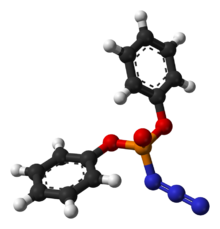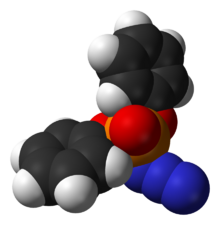Chemistry:Diphenylphosphoryl azide

| |

| |

| |
| Names | |
|---|---|
| Preferred IUPAC name
Diphenyl phosphorazidate[1] | |
| Other names
Diphenoxyphosphoryl azide
Diphenylphosphonic azide Diphenyl azidophosphate Phosphoric acid diphenyl ester azide | |
| Identifiers | |
3D model (JSmol)
|
|
| Abbreviations | DPPA |
| ChemSpider | |
| EC Number |
|
PubChem CID
|
|
| UNII | |
| |
| |
| Properties | |
| C12H10N3O3P | |
| Molar mass | 275.204 g·mol−1 |
| Appearance | Colourless or faintly yellow liquid |
| Density | 1.277 g/cm3 |
| Boiling point | 157 °C (315 °F; 430 K) (0.2 mmHg) |
| Hazards | |
| GHS pictograms |  
|
| GHS Signal word | Danger |
| H301, H311, H315, H319, H331, H335 | |
| P260, P261, P262, P264, P270, P271, P280, P284, P301+310, P302+350, P302+352, P304+340, P305+351+338, P310, P311, P312, P320, P322, P330, P332+313, P337+313, P361, P362, P363, P403+233 | |
| NFPA 704 (fire diamond) | |
| Flash point | 112 °C (234 °F; 385 K) |
Except where otherwise noted, data are given for materials in their standard state (at 25 °C [77 °F], 100 kPa). | |
| Infobox references | |
Diphenylphosphoryl azide (DPPA) is an organic compound. It is widely used as a reagent in the synthesis of other organic compounds.[3]
Uses
DPPA undergoes pseudohalogen replacement of the azido group by treatment with nucleophilic reagents, such as ammonia and various amines.[citation needed]
This compound is used as a reagent for the synthesis of peptides by virtue of its reactions with carboxylic acids leading to either the urethane or the amide. The formation of the urethane is particularly valuable since it works with carboxylic acids which fail to undergo the Schmidt reaction, and is believed to involve transfer of the azido group to the carboxylic acid.
It is now suggested that this reaction proceeds through the intermediate mixed anhydride, resulting from attack by the nucleophilic carboxylate anion on the phosphorus atom, with expulsion of the azide ion. The latter then attacks the carbonyl carbon atom, to give the acyl azide and loss of the diphenylphosphate anion, known to be a good leaving group. Finally, the acyl azide reacts in the normal manner to give the urethane.
Studies show that DPPA reacts with amines giving the corresponding phosphoramidates; it therefore appears that formation of the amide similarly involves the intermediate anhydride, followed by nucleophilic substitution by the amine.
In the synthesis of NSAIDs, DPPA is able to rearrange a propanoyl group into an isopropanoic acid.[4]
DPPA is also used to prepare an acyl azide for use in the Curtius reaction.
Safety
DPPA is very toxic and a potential explosive like most other azide compounds.
See also
References
- ↑ Nomenclature of Organic Chemistry : IUPAC Recommendations and Preferred Names 2013 (Blue Book). Cambridge: The Royal Society of Chemistry. 2014. pp. 923, 931. doi:10.1039/9781849733069-FP001. ISBN 978-0-85404-182-4.
- ↑ "Diphenyl azidophosphate" (in en). https://pubchem.ncbi.nlm.nih.gov/compound/123414#section=Safety-and-Hazards.
- ↑ R. J. W. Cremlyn (1973). "Some Reactions of O,O-Diphenylphosporyl Azide". Australian Journal of Chemistry 26 (7): 1591–3. doi:10.1071/CH9731591.
- ↑ Kawai, Nobutaka; Kato, Nobuharu; Hamada, Yasumasa; Shioiri, Takayuki (1983). "New methods and reagents in organic synthesis. 35. A new synthesis of some non-steroidal anti-inflammatory agents with the 2-arylpropionic acid skeleton by the use of diphenyl phosphorazidate (DPPA) as a 1,3-dipole". Chemical & Pharmaceutical Bulletin 31 (9): 3139–3148. doi:10.1248/cpb.31.3139. ISSN 0009-2363.
 |


